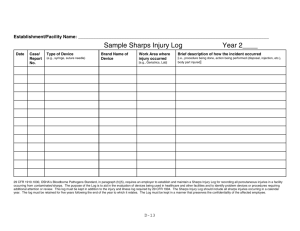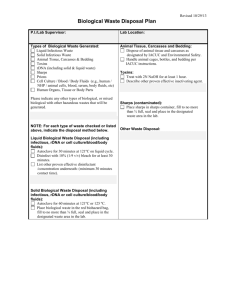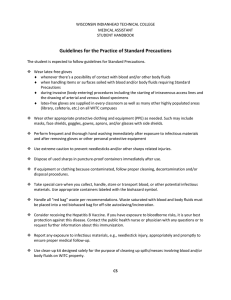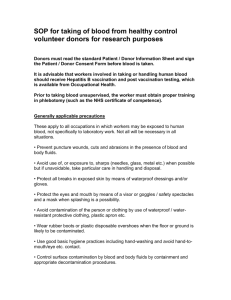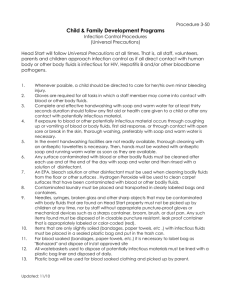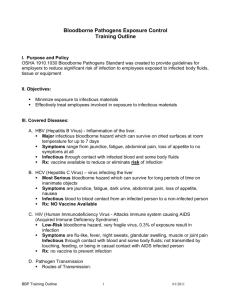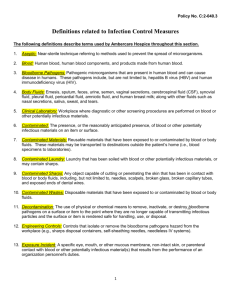Bloodborne Pathogen Exposure Control Plan Kirkwood Community College
advertisement
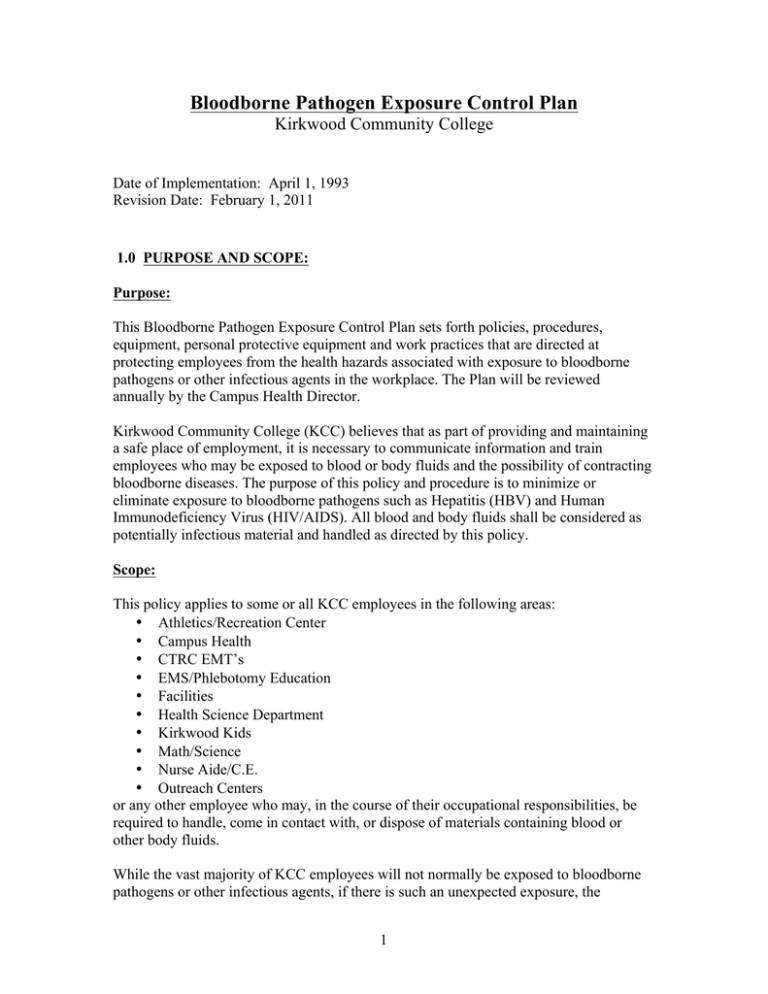
Bloodborne Pathogen Exposure Control Plan Kirkwood Community College Date of Implementation: April 1, 1993 Revision Date: February 1, 2011 1.0 PURPOSE AND SCOPE: Purpose: This Bloodborne Pathogen Exposure Control Plan sets forth policies, procedures, equipment, personal protective equipment and work practices that are directed at protecting employees from the health hazards associated with exposure to bloodborne pathogens or other infectious agents in the workplace. The Plan will be reviewed annually by the Campus Health Director. Kirkwood Community College (KCC) believes that as part of providing and maintaining a safe place of employment, it is necessary to communicate information and train employees who may be exposed to blood or body fluids and the possibility of contracting bloodborne diseases. The purpose of this policy and procedure is to minimize or eliminate exposure to bloodborne pathogens such as Hepatitis (HBV) and Human Immunodeficiency Virus (HIV/AIDS). All blood and body fluids shall be considered as potentially infectious material and handled as directed by this policy. Scope: This policy applies to some or all KCC employees in the following areas: • Athletics/Recreation Center • Campus Health • CTRC EMT’s • EMS/Phlebotomy Education • Facilities • Health Science Department • Kirkwood Kids • Math/Science • Nurse Aide/C.E. • Outreach Centers or any other employee who may, in the course of their occupational responsibilities, be required to handle, come in contact with, or dispose of materials containing blood or other body fluids. While the vast majority of KCC employees will not normally be exposed to bloodborne pathogens or other infectious agents, if there is such an unexpected exposure, the 1 procedures for decontamination, reporting of the incident and all post-exposure follow-up will be maintained. Any questions concerning the procedures in this Plan should be directed to the Campus Health Director. 2.0 DEFINITIONS: • Bloodborne Pathogens: Pathogenic microorganisms that are present in human blood and can cause disease in humans. The pathogens include, but are not limited to, hepatitis B virus (HBV), hepatitis C virus (HCV), and human immunodeficiency virus (HIV). • Contaminated: The presence or the reasonably anticipated presence of blood or other potentially infectious materials on a surface or in or on an item. • Engineering Controls: Controls (e.g. sharps disposal containers, needleless systems and sharps with engineered sharps injury protection) that isolate or remove the bloodborne pathogen(s) hazard from the workplace. • Engineered Sharps Injury Protection: § A physical attribute built into a needle device used for withdrawing body fluids, accessing a vein or artery, or administering medications or other fluids, which effectively reduces the risk of an exposure incident by a mechanism such as barrier creation, blunting, encapsulation, withdrawal or other effective mechanisms; or § A physical attribute built into any other type of needle device, or into a nonneedle sharp, which effectively reduces the risk of an exposure incident. • Exposure Incident: A specific eye, mouth, other mucous membrane, non-intact skin, or peripheral contact with blood or other potentially infectious materials that result from the performance of an employee's duties. • Other Potentially Infectious Materials (OPIM): § The following human body fluids: semen, vaginal secretions, cerebrospinal fluid, synovial fluid, pleural fluid, pericardial fluid, peritoneal fluid, amniotic fluid, saliva in dental procedures, and other body fluid that is visibly contaminated with blood such as saliva or vomitus, and all body fluids in situations where it is difficult or impossible to differentiate between body fluids such as emergency response; § Any unfixed tissue or organ (other than intact skin) from a human (living or dead); § Any of the following, if known or reasonably likely to contain or be infected with HIV, HBV, or HCV: o Cell, tissue, or organ cultures from humans or experimental animals; o Blood, organs, or other tissues from experimental animals; or 2 o Culture medium or other solutions. • Personal Protective Equipment: Specialized clothing or equipment worn or used by an employee for protection against a hazard. General work clothes (e.g., uniforms, pants, shirts or blouses) not intended to function as protection against a hazard are not considered to be personal protective equipment. • Sharp: Any object used or encountered that can be reasonably anticipated to penetrate the skin or any other part of the body, and to result in an exposure incident, including, but not limited to, needle devices, scalpels, lancets, broken glass, broken capillary tubes, exposed ends of dental wires and dental knives, drills and burs. • Standard/Universal Precautions: An approach to infection control. According to the concept of Universal Precautions, all human blood and certain human body fluids are treated as if known to be infectious for HIV, HBV, and HCV, and other bloodborne pathogens. 3.0 RESPONSIBILITIES: Campus Health: • • • • • • • Establish and update the written "Exposure Control Plan". Provide consultation to departments that have employees who may be exposed to bloodborne pathogens. Maintain copies of any "Illness and Injury Report Form" and report such injuries to the Insurance Program Manager. Maintain a "Sharps Injury Log" for all exposure incidents involving a sharp. Following an incident, ensure that the "Post Exposure Evaluations and Followup" provisions are completed and documented. Conduct Hepatitis vaccinations as necessary. Provide annual training for KCC employees via Target Safety. Deans, Directors, and Other Heads of Administration: • • • Provide the resources necessary to ensure that Personal Protective Equipment (PPE) is available for affected employees. Ensure that all employees who are determined to be at risk for BBP exposure are offered Hepatitis B vaccinations. Ensure that all exposure incidents are documented on the “Illness and Injury Report Form” and reported to the Campus Health Office. 3 Employees Covered by the Exposure Control Plan: • • • Understand the applicable components of the BBP Exposure Control Plan. Adhere to the practices and procedures of Universal Precautions. Report any exposure, accident, injury or illness to their supervisor or Campus Health. 4.0 EXPOSURE DETERMINATION Exposure determinations are based on an employee's reasonable potential for occupational exposure to blood or OPIM. The following exposure determination and task assessments shall be made without regard to the use of personal protective equipment. Category I: Tasks that involve direct contact with blood, body fluids, or tissues. All procedures, or other job-related tasks that involve an inherent potential for percutaneous, mucous membrane, or skin contact with blood or OPIM, are Category I tasks. The use of appropriate protective measures will be required for every employee engaged in Category I tasks. Category II: Tasks that involve no exposure to blood or OPIM, but may require performing unplanned Category I tasks. The normal work routine involves no contact with blood or OPIM, but contact may be required as a condition of employment. Appropriate protective measures shall be readily available for every employee engaged in Category II tasks. Department Job Classification Cat I Athletics/Recreation Coach/Athletic Trainer Center Cat II X Tasks First Aid Campus Health Campus Health Director/Registered Nurse X Direct patient care, cleaning of exam room surfaces CTRC EMT’s X Direct patient care EMS/Phlebotomy Education Clinical Faculty X EMT-B, Paramedic, Campus Health Back-up 4 Facilities Custodial/Maintenance X Health Science Clinical Faculty Kirkwood Kids Aide Math/Science Lab Faculty X Instruction involving body fluids Nurse Aide/CE Nurse Aide Faculty X Direct patient care Outreach Centers Coordinators X PRN Custodial/First Aid Direct patient care, Instruction involving body fluids X X First Aid PRN Custodial/First Aid 5.0 ENGINEERING AND WORK PRACTICE CONTROLS FOR COMPLIANCE Whenever practical and feasible, engineering controls shall be used as a first line of defense against occupational exposure to bloodborne pathogens. Work practice controls reduce employee exposure in the workplace by either removing or isolating the employee from exposure. Standard/Universal Precautions: Kirkwood Community College adheres to the practice of "Standard Precautions" to prevent contact with blood and other potentially infectious materials. Under circumstances in which differentiation between body fluid types is difficult or impossible, all body fluids shall be considered potentially infectious materials, regardless of the perceived status of the source individual. Sharps and Sharps Disposal: • Handling Contaminated Sharps: § Procedures involving the use of sharps in connection with patient care shall be performed using effective patient-handling techniques and other methods designed to minimize the risk of a sharps injury. § All sharps containers for contaminated sharps shall be easily accessible to personnel and located close to the immediate area where sharps are used. 5 § • • At KCC, sharps containers should be sealed shut with tape when ¾ full, placed in a red biohazard bag, and then placed in a closed and sealed biohazard box with the handles out. Facilities will then transport the waste to the Environmental Training Center for disposal according to state and federal regulations. Sharps Containers: § All sharps containers for contaminated sharps shall be rigid, puncture resistant, leak proof on the sides and bottom, and must be properly labeled. § All sharps containers shall be maintained upright throughout use, and replaced when necessary. § Sharps containers shall not be filled beyond the line indicated on the container itself, or no more than ¾ full. § Sharps containers shall not be reused. Prohibited Practices: § Shearing or breaking of contaminated needles and other contaminated sharps. § Contaminated sharps shall not be bent, recapped, or removed from the devices. § Sharps that are contaminated with blood or OPIM shall not be stored or processed in a manner that requires employees to reach by hand into the containers where these sharps have been placed. § Disposable sharps shall not be reused. § Broken glassware which may be contaminated shall not be picked up directly with the hands. It shall be cleaned up using mechanical means, such as a brush and dust pan, tongs, or forceps. § The contents of sharps containers shall not be accessed unless properly reprocessed or decontaminated. § Sharps containers shall not be opened, emptied, or cleaned manually or in any other manner which would expose employees to the risk of sharps injury. § Eating, drinking, smoking, applying cosmetics or lip balm, and handling contact lenses are prohibited in work areas where there is a reasonable likelihood of occupational exposure. § Food and drink shall not be kept in refrigerators, freezers, shelves, cabinets or on countertops or bench tops where blood or OPIM are present. 6 Regulated Waste: Regulated waste shall be placed in containers which are closeable, constructed to contain all contents, and prevent leakage of fluids during handling, storage, transport, or shipping. The waste must be labeled or placed in red bags and closed prior to removal to prevent spillage or protrusion of contents during handling, storage, transport, or shipping. Waste should be double bagged if there is a potential of leakage. All contaminated sharps and waste are bagged in red plastic bags, then boxed in biohazard boxes with handles, sealed with tape and transported by Facilities to the Environmental Training Center (ETC) on Kirkwood Campus. The ETC is responsible for disposal according to state and federal regulations. Handling Specimens: Specimens of blood or other potentially infectious materials shall be placed in a container which prevents leakage during the collection, handling, processing, storage, transport, or shipping. The container used for this purpose will be labeled or color-coded in accordance with the requirements of the OSHA standard. If outside contamination of the primary container occurs, the primary container shall be placed within a second container which prevents leakage. Cleaning and Decontamination: Facilities staff at KCC are generally responsible for all clean up of bloodborne pathogens. The Facilities office provides biohazard waste cleaning products for clean up. • All custodial procedures will be conducted in a manner which will minimize splashing, spraying, and splattering of droplets of blood or other potentially infectious body fluids. • All equipment, receptacles, environmental, and working surfaces will be cleaned and decontaminated after contact with blood or other potentially infectious body fluids. Contaminated work surfaces, receptacles, and protective coverings will also be removed immediately or as soon as feasible if they cannot be decontaminated in their original location. All work surfaces will be decontaminated at the end of the work shift if the surface may have become contaminated since the last cleaning. Each department is responsible for maintaining an appropriate cleaning and decontamination schedule. • Contaminated equipment, which may be contaminated with blood or other potentially infectious body fluids, shall be examined and decontaminated prior to servicing or shipping (unless this is not feasible). A label shall be attached to equipment stating which portions may be contaminated. • All bins, pails, cans and similar receptacles shall be inspected and decontaminated on a regular basis as needed by the designated person for each department. 7 • All broken glassware that may be contaminated will not be picked up directly with the hands. Use a mechanical device (forceps, dustpan and broom). • Disinfectants and/or germicides shall be applied to working area surfaces to ensure the area is maintained in a clean and sanitary condition. • Protective clothing shall be worn during clean-up procedures (i.e. gloves, goggles). Work Area Restrictions: In work areas where there is a reasonable likelihood of exposure to blood or other potentially infectious body fluids, employees must not eat, drink, apply cosmetics or lip balm, chew gum or tobacco, smoke or handle contact lenses. Food and beverages are not to be kept in refrigerators, freezers, shelves, cabinets, or on counter tops or bench tops where blood or other potentially infectious body fluids are present. All procedures taking place in the work place will be conducted in a manner which will minimize splashing, spraying, and splattering of droplets of blood or other potentially infectious body fluids. 6.0 PERSONAL PROTECTIVE EQUIPMENT (PPE): All personal protective equipment used at Kirkwood Community College will be provided without cost to employees. PPE will be chosen based on the anticipated exposure to blood or other potentially infectious body fluids. The PPE will be considered appropriate only if it does not permit blood or other potentially infectious fluids to pass through. It must prevent exposure of the employee's clothing, skin, eyes, mouth and other mucous membranes under normal conditions of use and for the duration of time which the PPE will be used. • Each KCC department manager shall ensure that the appropriate PPE, in the appropriate size, is readily accessible at the work site. Hypoallergenic gloves, glove liners, powder-free gloves, latex-free gloves or other similar alternatives shall be readily accessible to those employees who are allergic to gloves normally provided. • All PPE will be cleaned, laundered, disposed, repaired and/or replaced by the employer at no cost to the employees. All garments, which are penetrated by blood, shall be removed immediately or as soon as feasible. All PPE will be removed prior to leaving the work area. When the PPE is removed, it shall be 8 placed in an appropriate designated area or container for storage, washing, decontamination, or disposal. • Gloves shall be worn where it is reasonably anticipated that employees will have hand contact with blood, other potentially infectious fluids, non-intact skin and mucous membranes. Disposable gloves used at this facility and in the clinical areas are not to be washed or decontaminated for re-use. They are to be replaced as soon as practical when they become contaminated or as soon as feasible if they are torn, punctured, or when their ability to function as a barrier is compromised. KCC Facilities staff may use utility gloves if they are decontaminated for re-use and the integrity of the glove is not impaired. They should be discarded and replaced if they exhibit signs of deterioration and can no longer function as a barrier to BBP exposure. • Disposable masks to protect the face and eye protection devices, such as goggles or glasses with solid side shield, or chin length face shields, may be required whenever splashes, spray, splatter or droplets of blood or other potentially infectious body fluids may be generated and eye, nose, and / or mouth contamination can reasonably be anticipated. • CPR masks are located in all first aid kits throughout campus. Campus Health provides and re-stocks all first aid kits without charge to the individual departments. • Gowns, aprons, lab coats, jackets, surgical caps and/or shoe covers should be provided and utilized when gross contamination is reasonably expected. Disposal and laundering should follow guidelines as recommended with other PPE. All supervisors of employees shall ensure the appropriate use of the PPE unless the supervisor shows that the employee or student has temporarily declined to use the PPE when under rare and extraordinary circumstances. In the supervisor's professional judgment that in the specific circumstance, the employee will be prevented of delivering healthcare or poses an increased hazard to the safety of the co-worker. This circumstance shall be documented in order to determine whether changes can be instituted to prevent such occurrences in the future. 7.0 HEPATITIS B VACCINATION: The hepatitis B vaccination series shall be made available to all employees who have been determined to be at risk for BBP exposure unless the employee has previously received the complete hepatitis B vaccination series, and antibody testing has revealed that the employee is immune, or the vaccine is contraindicated for medical reasons. 9 The hepatitis vaccination program consists of the following: • Made available at no cost to eligible employees. • Made available to the employee at a reasonable time and location. • Performed under the supervision of a licensed physician or healthcare professional. • Provided according to the recommendations of the U.S. Public Health Services. • Made available after the employee has received the training in occupational exposure and within 10 working days of initial assignment to all employees who have occupational exposure. • If an employee initially declines the hepatitis B vaccination, but at a later date chooses to receive the vaccination while still eligible and employed by Kirkwood Community College, the vaccination shall then be made available. • All employees who decline the hepatitis vaccination shall sign the Hepatitis B Vaccination Declination Form. • Documentation of HBV series or waiver will be kept on file in the Kirkwood Community College Campus Health office. 8.0 BBP POST-EXPOSURE EVALUATION & FOLLOW-UP: Bloodborne pathogen exposure is defined as contact (skin, eye, mucous membrane or parenteral) with: • Blood • Body tissues or organs • Semen • Vaginal secretions • Amniotic fluid • Cerebral spinal fluid • Pericardial fluid • Peritoneal fluid • Pleural fluid • Synovial fluid or other body fluids containing visible blood through injuries from contaminated sharps, breaks in the skin, skin conditions or mucous membranes. OSHA requires documentation of the route of exposure, circumstances in which it occurred, identification and documentation of the source individual (if feasible), testing of the source individual’s blood for HBV and HIV infectivity if feasible and unknown upon exposure, notification of results of the source HBV and HIV status to the exposed employee (within applicable state laws / regulations), collection and testing of the exposed employees blood for HIV and HBV, documentation of follow-up treatment 10 including test results, prophylactic medications, counseling and evaluation of reported illnesses. At KCC, Campus Health is responsible for retaining all of the above documentation as part of the employee’s medical file. Communication with the exposed employee about testing, vaccination and medical conditions resulting from exposure should be discussed and instructions provided in writing within 15 days of exposure. Procedures Following an Exposure: Low risk BBP exposure: When the potential for transmission of infectious agents is unlikely or non-existent. This includes contact with urine, saliva, tears, sweat, sputum and stool which contain no obvious blood, puncture or laceration from sharps not contaminated with blood or body fluid, exposure of blood to intact skin, or puncture from a hollow point needle used to administer fluids or medications into an IV line if no blood is visible in the IV tubing. Treatment: For these exposures, wash the affected area immediately. Your intact skin is a protective barrier and follow up care is not necessary. Complete the Kirkwood Community College Illness and Injury Report form and notify Campus Health of your low risk exposure. High risk BBP exposure: When the incident poses a significant potential for the transmission of infectious agents. This includes a break in the skin from any kind of a sharp (needle, lancet, glass, surgical instrument) that is contaminated or likely contaminated with blood or body fluid / tissue, contact with blood or body fluid into an open skin lesion, splashes of blood or bloody material into or very near the eyes, nose, or mouth, CPR with direct mouth to blood contact, and any other situation where there is a high probability of contamination. Treatment : • Wash the affected area immediately and thoroughly with soap and water. • Report the incident to a clinical instructor or supervisor after cleaning the area. • For students, the clinical instructor will notify the clinical area supervisor of the incident. • The instructor or supervisor notifies Kirkwood Campus Health for referral instructions at 398-5588 or cell phone 389-3651 IMMEDIATELY upon exposure. If the Campus Health Director is not available or the Campus Health Office is closed, immediately send the exposed individual to the nearest emergency room; in Cedar Rapids go to St. Luke's. • The clinical instructor or supervisor will start the following paperwork and send this with the student / staff to the emergency room: § A copy of the Kirkwood Community College Illness and Injury Report form. § Body Fluid Exposure - Risk Management Form § Name, address and phone of the source person (person who's blood or body fluid you came in contact with, as they will be tested as well) 11 • • The exposed student or staff must contact Campus Health at 132 Iowa Hall within 72 hours of the exposure. The Campus Health Director will review the follow up process, schedule follow up counseling and testing through St. Luke's Workwell Clinic and complete the required paperwork. All non-emergent follow-up care and appointments must occur at St. Luke’s Workwell Clinic, our designated employee and student health facility. Failure to follow up with Campus Health may cause the student or staff member to be billed individually for the costs of the emergency room visit and lab fees. OSHA requires all evaluations, follow-up, prophylactic treatment and testing be made available at no cost to the employee. 9.0 COMMUNICATION OF HAZARDS TO EMPLOYEES: Communicating hazards to employees who may potentially come into contact with bloodborne pathogens is a vital component of this program in order to eliminate or minimize exposure. Signs and Labels: • • • The proper biohazard labels shall be affixed to all collection or storage containers of potentially infectious materials. This includes regulated waste, refrigerators, freezers, equipment and other containers used to store, transport or ship blood or other potentially infectious materials. The labels shall include the universal biohazard symbol and the legend BIOHAZARD. In the case of regulated waste, BIOHAZARDOUS WASTE may be substituted. The labels shall be fluorescent orange or orange-red. Information and Training: Employee training will be conducted prior to assignment of tasks where the potential for occupational exposure to bloodborne pathogens are present. In addition, these employees will be retrained at least annually on the following elements: • A general explanation of the epidemiology and symptoms of bloodborne diseases. • Information regarding the modes and methods of transmission of bloodborne disease. • An explanation and an accessible copy of the campus Exposure Control Plan. • Appropriate methods for recognizing tasks and other activities that may involve exposure to blood and other potentially infectious materials • Use and limitations of methods that will prevent or reduce exposure including appropriate engineering controls, administrative or work practice controls, and personal protective equipment. • Information on the types, proper use, location, removal, handling, decontamination and disposal of personal protective equipment. 12 • • • • • • • • Information on the hepatitis B vaccine, including information on its efficiency, safety, method of administration, the benefits of being vaccinated, and that the vaccine and vaccination will be offered free of charge. Appropriate actions to take and persons to contact in an emergency involving blood or other potentially infectious materials. Procedures to follow for bloodborne pathogen clean-up and disposal. Procedures to follow if an exposure incident occurs, including the method of reporting the incident and the medical follow-up that will be made available and the procedure for reporting the incident to Campus Health. Information on the post-exposure evaluation and follow-up that is provided following an exposure. An explanation of the signs, labels, and color coding requirements. An opportunity for interactive questions and answers. All training shall be documented and maintained for a period of at least 3 years. 10.0 RECORDKEEPING: Annual BBP Training: At Kirkwood Community College, training is provided in a web-based format from a contracted company, Target Safety, or by the Continuing Education Department. Proof of training outside KCC will be accepted, as long as the training record requirements listed below are included. • • • • The date of the training session. Contents or a summary of the training session. The name and qualifications of the person conducting the training. The name and job title of the person attending the training. Kirkwood Community College will keep records of annual BBP training on file for 3 years, either in a computerized or hard copy format, in the employees’ departmental or Campus Health record. These records should be readily available to OSHA for audit. Medical Records: • • • Medical records, training records, and exposure incident reports shall be maintained in the Campus Health office. All medical records shall be confidential and will not be disclosed to any person except where regulation requires. In accordance with 29 CFR 1910.1020, each record will be maintained for the duration of employment plus 30 years. The records shall include the following: § The name and social security number of employee. § A copy of the employee's HBV vaccination status, including the dates of vaccination and ability to receive vaccination. 13 § § § A copy of all results of examination, medical testing, and follow-up procedures. A copy of the information provided to the healthcare professional. A confidential copy of the healthcare professional's written opinion. Sharps Injury Log: Effective January 1, 2002, OSHA requires a Sharps Injury Log to be maintained for recording percutaneous injuries from contaminated sharps. This act also requires employers to consider implementation of new safer medical devices to prevent needlestick injuries. This log shall contain: • • • The type and brand of device involved in the incident. The department or work area where the exposure occurred (maintain confidentiality of employee). An explanation of how the injury occurred (maintain confidentiality of employee). In addition to this log, complete documentation of the incident will be recorded on the Kirkwood Community College Injury and Illness Report form and kept on file in Campus Health. Exposure Incident Logs: This generalized log will be kept in the BBP Exposure Control Manual to document the date, route and general circumstances of all exposures. Supervisors can use these examples to educate their employees and re-emphasize the importance of exposure control methods. All exposures will be fully documented on the Kirkwood Community College Illness and Injury Report form, which will be kept on file in Campus Health. This form should contain documentation of the route of exposure, circumstances under which the exposure occurred, ID and documentation of the source individual, the source individual’s blood test results if available (maintaining legal release / consent and confidentiality), the exposed employee’s blood results, employee’s vaccination status, post-exposure treatment, including any prophylactic therapy, counseling and evaluation. Reviewed 10/10 KDP 14
